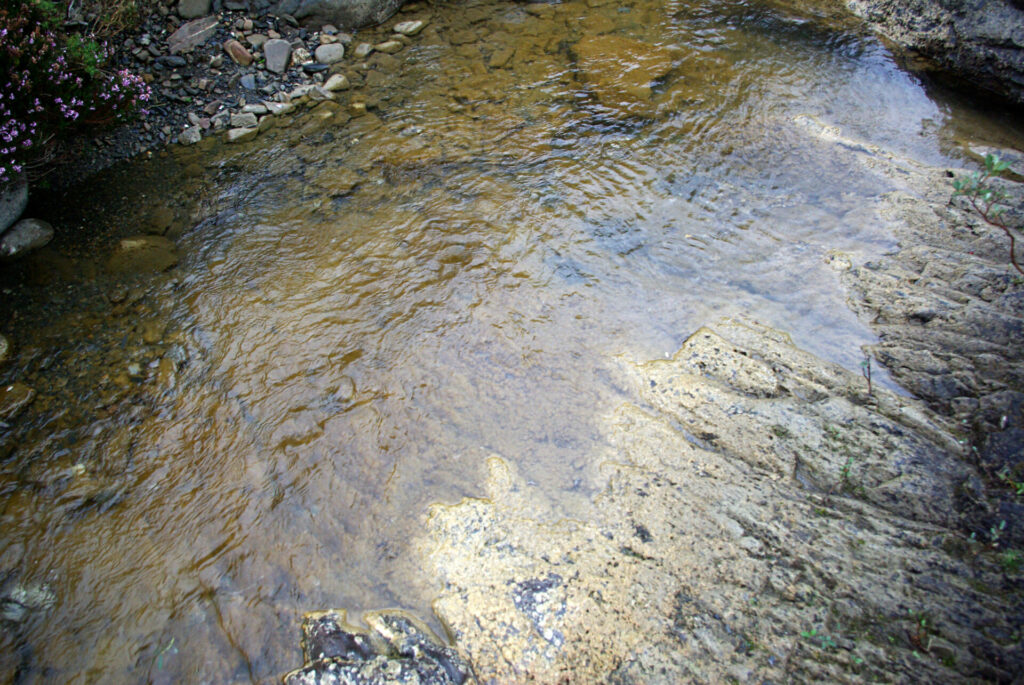
Didymo (colloquially called “rock snot”) is an aquatic diatom native to cool-water regions of northern Europe and North America. It can grow into thick, brown mats that cover rocks and streambeds, choke waterways, and threaten entire aquatic ecosystems. This summer, PA DCNR confirmed didymo’s presence in Meadow Run, just above the Youghiogheny River.
Didymo colonies can start from just one cell. Bunches of cells group together to form large, dense colonies called algal blooms – that’s the lumpy, goopy stuff you can see in the stream. Young colonies look like pimples on rocks, but they will grow and elongate to form long stalks. Those stalks eventually form the thick mats that look slimy, but are actually coarse and wooly to the touch. Since didymo lacks chlorophyll, the blooms are brown, yellow, or white.
When it blooms, didymo can become a major problem. It covers rocks and streambeds, reducing habitat and food availability for invertebrates. By altering the aquatic invertebrate food base, didymo also harms the trout population. This organism could be devastating for a big chunk of Pennsylvania’s fishing economy, which generates over $400 million each year according to the American Sportfishing Association.
Unlike the harmful algal blooms that plague lakes with warm water and excess nutrients, didymo thrives in cold, low-nutrient streams – waterways that are also good habitats for native species like brook trout and eastern hellbenders. However, didymo has recently shown a tolerance for different water chemistry and expanded to diverse areas including British Columbia, Canada, New Zealand, and the western United States.
The algae was observed in the Youghiogheny River at Ohiopyle in 2012. The most recent bloom was confirmed in Meadow Run after Ohiopyle State Park managers realized that the stream’s macroinvertebrate (stream bug) diversity was low, which prompted further investigation by DCNR. The Dept of Environmental Protection’s Water Quality Standards team of Aquatic Biologists confirmed the presence and are concerned about the overall health of Meadow Run. Based on this finding, it’s likely that didymo is present in other tributaries, and also possibly in the Yough.
Researchers don’t know exactly why didymo is spreading, or how to stop it. This tenacious organism can cling to hard surfaces for up to 40 days, and only one cell is needed for it to spread. Anglers, kayakers, canoeists, boaters, swimmers, and hikers can unknowingly spread didymo on their gear, waders, boots, and boats.
Stop the spread! Check – Clean – Dry!
Follow these guidelines to help prevent the spread of didymo. These activities are especially important if you have been in waters where didymo or other invasive species are known to exist. Before moving to a new location in a different body of water:
• REMOVE debris and strands of alga from your gear
• CLEAN all gear in 2.5-5.0% solution of household bleach and hot water for 10 minutes, or scrub with dish soap and hot water. You can also freeze gear until frozen solid.
• DRY all gear to touch, and then continue drying time for at least 48 more hours.
- Dispose of disinfection solution into a treated wastewater system. Soap solution should only be disposed of into wastewater system. Other disinfection solutions can be disposed of outdoors, but dispose at least 350 feet from water.
- In the wilderness or camping: Follow the guidelines above for checking and removing debris from your clothing and gear, and DRY your items completely for at least 48 hours before entering a new waterbody, or carry “clean” gear for use in other waters.
- AVOID FELT-SOLE WADERS: Use non-absorbent alternatives, including carbide stud replacement soles, detachable cleats, and sticky rubber.
Report It!
If you think you’ve seen a didymo bloom, please report it! Photos and GPS coordinates are very helpful to include in your report.
Report online at the PA Fish and Boat Commission website, as well as PA iMapInvasives at: https://www.paimapinvasives.org/ and at the national level, USGS Nonindigenous Aquatic Species website: https://nas.er.usgs.gov/SightingReport.aspx

